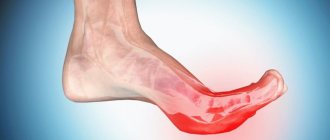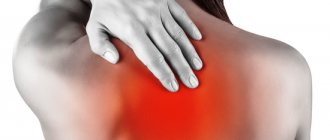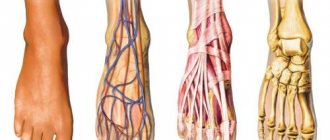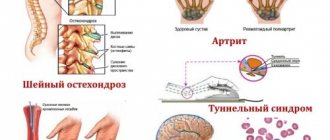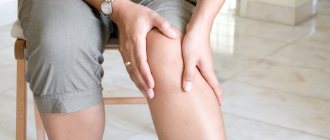In the article we discuss the bunion on the big toe. You will learn everything about why it appears, what it threatens, how to get rid of it, and whether there are preventative measures for hallux valgus.
Bone on the big toe. Photo.
- Why does a bunion form and hurt?
- Symptoms of a bunion on the big toe
- Treatment of a bunion on the big toe
- Choosing shoes for bunions
- Prevention of bunions on the big toe
- Bone on the big toe - reviews
- What to remember
Why does a bunion form and hurt?
A protruding bunion on the big toe bothers a fairly large number of people. For the time being, it does not cause any inconvenience at all. But if you do not take any therapeutic and preventive measures, then the diseased bone on the big toe will begin to bring a lot of trouble , which can lead to pathological changes in the foot.
What is the name of bunion disease? In the medical reference book this diagnosis is called hallux valgus.
Valgus deformity - this disease manifests itself not only in external changes in the finger, but in the future it can threaten pathological diseases of the musculoskeletal system and problems with blood vessels.
Let's figure out why the lateral bone on the leg increases:
- heredity;
- excess weight;
- flat feet;
- joint diseases;
- foot injury;
- constant mechanical loads on the foot;
- endocrine diseases;
- lack of microelements;
- diseases of the autoimmune system.
The disease can also develop with age. This is due to significant changes in the body, general weakening and the presence of chronic diseases.
This disease mainly affects women. According to medical statistics, in the weaker half of humanity, a bunion on the toe pops out 20 times more often than in men.
Over time, the bunion that has formed on the big toe begins to hurt very much, and if you ignore the symptoms, it can all end in surgical intervention.
Tips for preventing foot deformities
- Avoid wearing tight and uncomfortable shoes. Give preference to shoes made from natural materials that provide greater comfort.
- High-heeled or stiletto shoes can cause foot deformities because they place stress on the toes and joints.
- Special interdigital cushions help normalize the position of the toes during sleep.
- Consult an orthopedic specialist about choosing special insoles and arch supports for shoes to reduce the load on your toes and relieve pain.
- Take vitamins A and C, calcium and vitamin D to strengthen your bones and joints.
- In some cases, when the position of the big toe is deviated, orthopedic splints are used. They help restore health to your feet and avoid surgery.
- Maintain a healthy weight and avoid obesity. Excess weight is one of the main problems affecting foot deformation.
Symptoms of a bunion on the big toe
First of all, a progressive bunion has external signs. This is expressed by a clear bulging of the lump, which brings more and more painful sensations as it grows. There are 4 degrees of hallux valgus:
| Degree of hallux valgus | Signs |
| 1st degree | The thumb is slightly misaligned. A slightly noticeable bone thickening begins to form. A small tumor may appear near the bone. The bone practically does not cause any inconvenience. Is that sometimes after prolonged physical activity there is slight discomfort. |
| 2nd degree | The lateral bone at this stage is already shifted by 20-30 degrees. Now you already noticeably feel discomfort during and after walking. The skin in the area of damage begins to turn red. |
| 3rd degree | The bone is already clearly sticking out - 30-50 degrees. You quickly get tired of walking, pain accompanies you constantly, although it is still quite tolerable. |
| 4th degree | Calluses form on the phalanges. The pain causes significant discomfort. Lameness and stiffness of movement may occur. |
Why does deformation occur?
First, a little theory: there are two arches in the foot - longitudinal and transverse. The purpose of both is shock absorption and maintaining balance while walking. The heads of the metatarsal bones are located in the transverse arch, forming an arch shape.
| Risk factors | |
| Hallux valgus is almost always accompanied by transverse flatfoot, which can be either congenital or acquired. Bumps can also appear due to hereditary predisposition, excess weight, osteoporosis, foot injury and, unfortunately, wearing the wrong shoes. Thus, in Japan, wide open shoes were traditionally used, but after World War II, the Japanese began to wear European-style shoes - and immediately the number of foot deformities increased by 67%. The fact is that narrow shoes and high heels increase the load on the forefoot, which means the biomechanics of the big toe are disrupted. Therefore, prolonged walking in dress shoes or boots is very, very not recommended. | |
The deformity occurs due to the deviation of the head of the first metatarsal bone inward, and the phalanges of the big toe outward. In this case, the load of the foot is redistributed. The heads of the middle metatarsal bones are overloaded and gradually lower, becoming fixed in the wrong position. In this regard, the appearance of calluses on the soles of the feet is an alarming bell, because “calluses” are an external sign of prolonged pressure of the lowered heads of the metatarsal bones on soft tissues, as a result of which the layer of subcutaneous fatty tissue is reduced and the shock-absorbing properties of the foot are reduced.
Thus, deviation of the big toe is a consequence of deviation of the metatarsal bone.
Treatment of a bunion on the big toe
Bunions on the legs on the side require mandatory treatment. If you just suspect the disease, or you have put too much pressure on a bone in your foot, you need to consult an orthopedist.
There are a number of treatment methods for bunions (valgus):
- pharmaceutical products;
- surgical treatment;
- folk remedies;
- physiotherapeutic measures;
- special gymnastics;
- foot massage;
- corrective shoes;
- taping the thumb bone;
- orthopedic devices.
Most often, doctors prescribe several treatment methods at once, since the disease is quite serious and requires long-term therapy.
Medications
On forums they discuss what to do if a bone hurts in your foot. First, consult a doctor - this is the most important thing you can do in this situation. If you have a bunion near your big toe, your doctor may prescribe the medications listed in the table.
| Drug name | Release form | Mode of application |
| Valgusstop | Natural based ointment. | Apply several times a day with light massage movements until completely absorbed. |
| Bishofite | Cream based on minerals. | Use 2-3 times a day, rubbing lightly into the foot and bone. |
| Diprospan | Injection. | The dose of diprospan is calculated depending on the clinical picture and severity of the disease. |
| Kenalog | Suspension for injection. | When administered intra-articularly, as well as when administered into the affected area, the dose is 10-40 mg. The interval between administrations is at least 1 week. |
As you have already seen from the above list, not only external agents are used in the treatment of valgus. You may also be prescribed pills or injections. You should not self-medicate; only an experienced doctor can determine the required dose that will bring a minimum of side effects.
To treat the bone on the thumb, Chlorophyllipt and Dimexide are used, as well as iodine with aspirin, and medical bile is used.
Physiotherapy
Correction of the bunion on the big toe is carried out using physiotherapy:
- air baths;
- compresses;
- acupuncture;
- water and mud therapy;
- barotherapy;
- cryotherapy;
- myostimulation;
- electrical and electromagnetic influence.
For example, electromagnetic procedures can be carried out with the same Bishofite. The nurse applies cream to the foot and bunion, and only then carries out physiotherapeutic manipulations.
Due to electromagnetic waves, the medicine penetrates faster and deeper into damaged tissues and begins to more actively affect the deformed joint.
This method of treatment is indicated at all stages of the disease. It is often combined with drug treatment to enhance the effect of pharmaceutical drugs.
Massage
Foot massage also refers to physiotherapy. There are several ways to carry out this manipulation. Even a professional massage will not immediately relieve you of this pathology, but it can significantly reduce the pain.
If you decide to do the massage yourself, here are a few rules:
- Under no circumstances put pressure on the lump itself.
- Movements should be light. You kind of make circles around the growth.
- At first the pressure should be very weak, then gradually increase the pressure.
- The duration of the massage is 10−15 minutes.
Due to massage, blood circulation in the affected area increases, which helps restore bone tissue and relieve inflammation.
Manual specialists also recommend non-contact massages:
- Take a warm foot bath. The duration of the procedure is 10−15 minutes. You can add a little sea salt to a bowl of water.
- Take a special roller and place your feet on your feet.
- With force, spread your toes as far as possible while moving the roller.
In this way, you strengthen the muscles and ligaments, preventing the joint from becoming even more deformed. According to reviews, this remedy for bunions is not only useful, but also pleasant.
Gymnastics
The forums often discuss the topic of how to get rid of bunions using special exercises. There are quite a lot of gymnastic techniques. All of them are aimed at relieving inflammation in the affected area and straightening the deformed joint.
Here are some exercises to correct your big toe bunion:
| Exercise name | Execution Method |
| We lift objects | Scatter small objects on the floor and try to grab them with your toes. If possible, hold the object in this position for several minutes. The more trained your fingers become, the more slippery and small objects you need to select. |
| Bike | This exercise should be done with emphasis on the feet. Imagine that you are riding a bicycle and pedaling only with your toes. Your shins should move parallel to the surface you are lying on. Arch your foot: it is straight when the “pedal” is in front, then pull your toe towards you. |
| Alphabet | While lying down, write numbers and letters in the air with your heel. |
| Geometry | Try actually writing the alphabet. Sit on a chair with your hands on your knees. Take a pen or pencil with your toes and try to draw geometric shapes on a piece of paper. |
Tires, ties and clamps
Along with medications and manual treatments, doctors recommend that patients use orthopedic devices. According to reviews from those who have growing bunions, the following are considered the most effective:
- silicone and gel interdigital rollers;
- magnetic patches;
- semi-rigid hinged and rigid night clamps;
- orthopedic splints;
- rubber ties.
It is better to discuss the purchase of this or that product with your doctor. With the wrong device, you can only worsen your condition.
Bone on the big toe - reviews
Traditional treatment for bunions receives varying reviews. Various methods of treating bunions are discussed on forums.
Irina, 43 years old
I was treated for a long time and tediously with the help of ointments - nothing helped. Until the orthopedist prescribed a special insole. I looked on the forums for treating a bunion on my big toe using this device and only then decided on what would definitely suit me. The bone has not yet shrunk, but at least I have stopped suffering from pain.
Anna, 38 years old
Judging by the reviews, it is extremely difficult to cure a bunion. I didn’t experiment - I went straight to the doctor. He prescribed injections and physiotherapy. I took a course of mud therapy at the sanatorium. The effect of the mud did not come immediately. But after a couple of months I felt that the pain had become much less.
